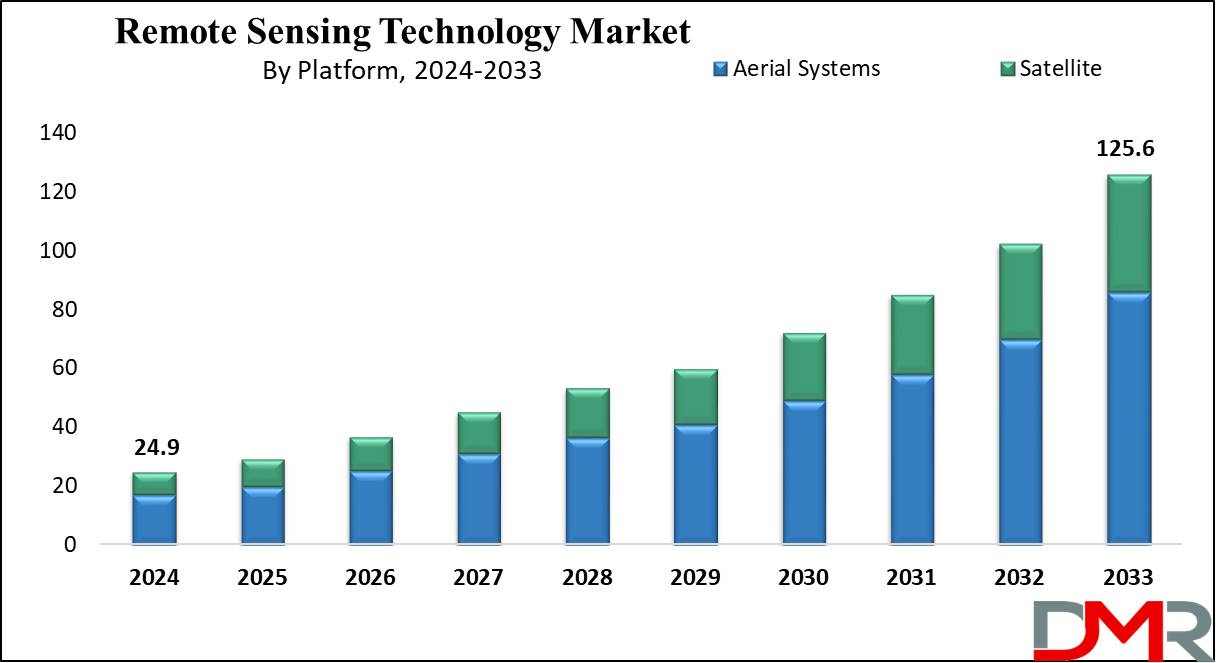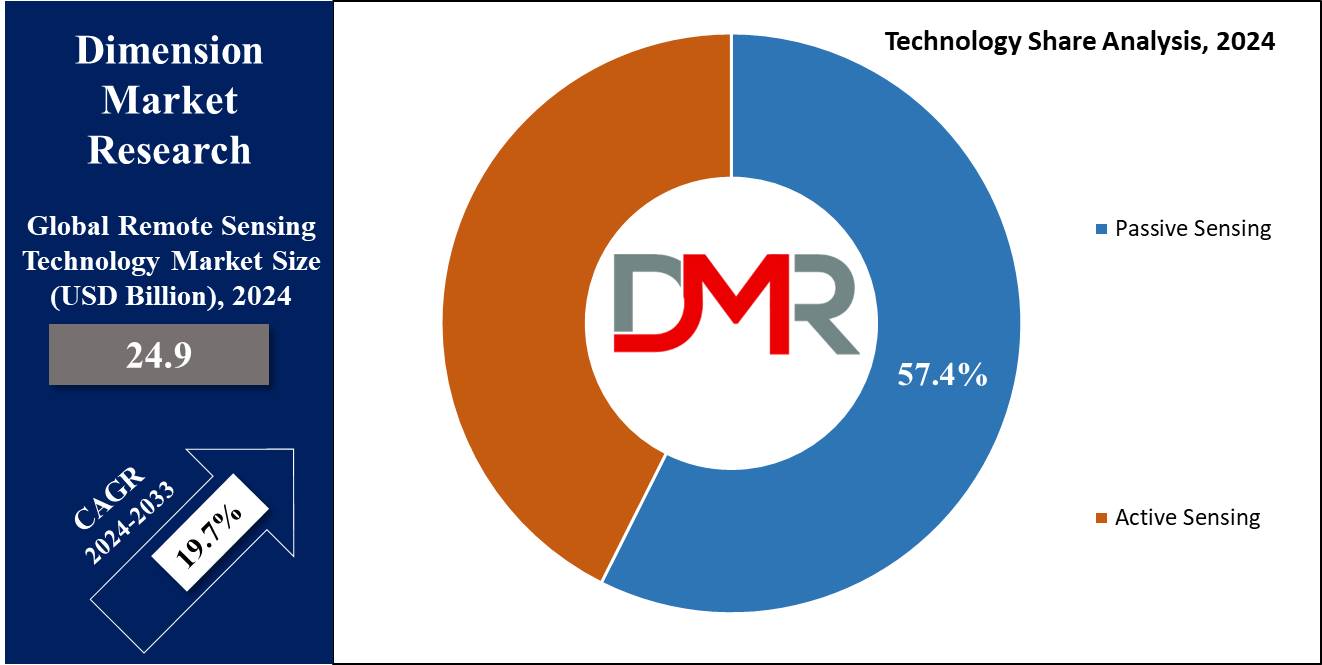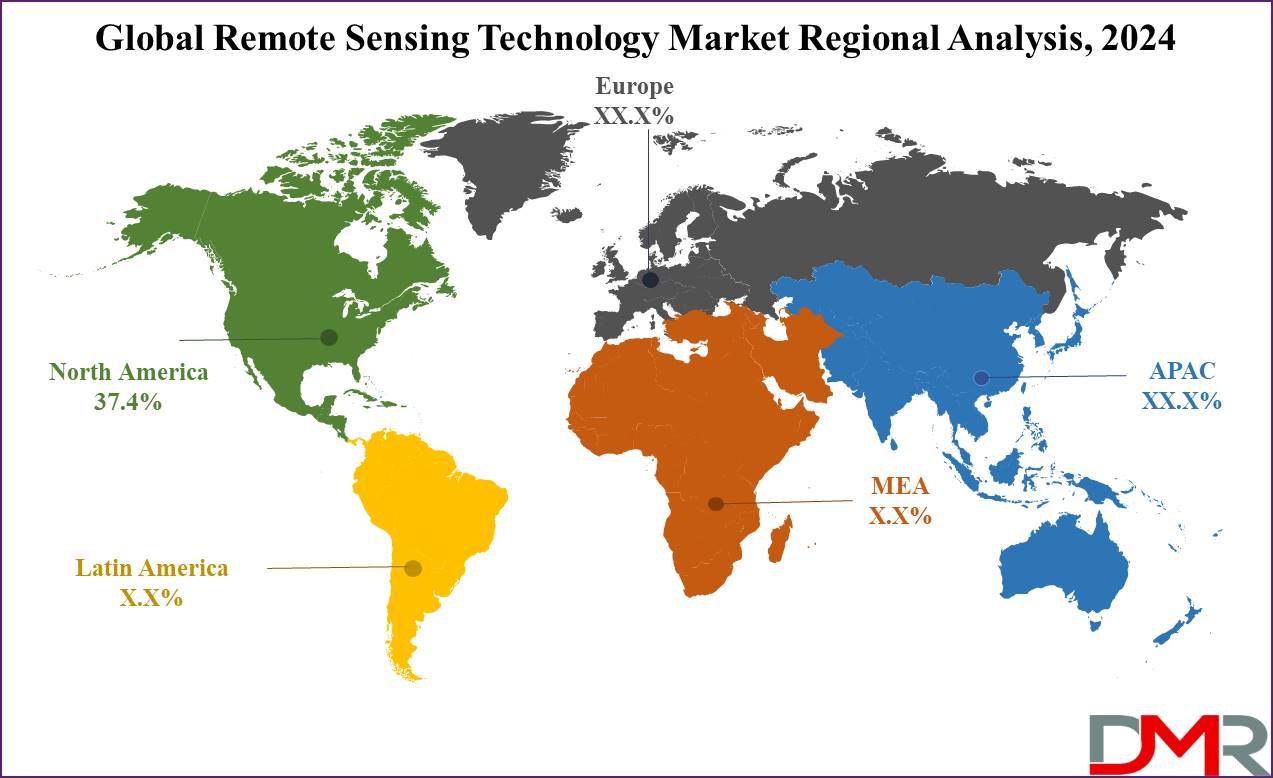Remote sensing is a geospatial technology that uses electromagnetic (EM) radiation emitted and reflected from Earth's terrestrial, atmospheric, and aquatic ecosystems to detect & monitor physical characteristics without direct physical contact.
It typically employs passive and active sensor technologies based on aircraft and satellites for remote sensing; passive sensors collect radiation that has been reflected by objects in response to external stimuli - typically sunlight; active sensors use internal stimuli by emitting energy that scans objects & areas before measuring the energy reflected from targets to detect and monitor physical characteristics without physical contact.

The global remote sensing technology market is seeing rapid expansion due to advancements in satellite imaging technology, drones and sensor products. Demand for high-resolution satellite images with real-time analysis for use in sectors like agriculture, environmental monitoring and urban planning drives this expansion, while governments and organizations increasingly utilize remote sensing for resource management purposes and decision making purposes.
The defense and security industries have also played a crucial role in advancing remote sensing technologies. Improved surveillance, border control, intelligence gathering through remote sensing tools is in high demand; furthermore these tools play a crucial role in disaster management by tracking natural calamities such as hurricanes, floods and wildfires for quick responses from emergency managers.
UAVs and drones have transformed remote sensing applications. These devices offer increased precision data collection capabilities in hard-to-reach or hazardous locations. Drones have increasingly become part of agricultural monitoring programs, wildlife tracking efforts, infrastructure inspection services and energy infrastructure inspection - expanding remote sensing technologies across industries.
Opportunities exist within smart city development and sustainability initiatives. By integrating remote sensing technology into urban planning, remote sensing technology is improving traffic management, waste disposal and energy efficiency while its focus on environmental sustainability has opened new vistas in climate monitoring, forest conservation management and ecosystem conservation.
As per statista The remote sensing services market reached 17.1 billion U.S. dollars globally in 2023 and is expected to grow rapidly, surpassing 37 billion U.S. dollars by 2030. This technique involves detecting and observing physical properties of areas using radiation measurements from a distance, primarily through commercial satellites. Key applications include consumer navigation devices and services.
The US Remote Sensing Technology Market
The US Remote Sensing Technology Market is projected to reach USD 1.3 billion in 2024 at a compound annual growth rate of 13.4% over its forecast period.
U.S. remote sensing technology market opportunities include integrating AI and big data analytics, which enhance data processing and predictive capabilities, while low-cost satellites and CubeSats expand access to high-resolution earth observation. Recent trends include multi-source data integration between satellites, drones, and ground
sensors for more comprehensive environmental monitoring and enhanced decision-making.
Further remote sensing technology market in US is being driven by rapid developments in satellite and drone technologies that improve data accuracy for use across industries like agriculture and defense, though high initial costs and ongoing maintenance expenses act as barriers to smaller organizations, as do issues surrounding data privacy and security that complicate remote sensing system deployment and management - ultimately inhibiting market expansion.
Key Takeaways
- Market Growth: The Remote Sensing Technology Market size is expected to grow by 96.3 billion, at a CAGR of 19.7% during the forecasted period of 2025 to 2033.
- By Platform: The aerial systems segment is expected to lead in 2024 with a major & is anticipated to dominate throughout the forecasted period.
- By Technology: The remote sensing technology is expected to lead the Remote Sensing Technology market in 2024.
- By Application: The military & intelligence sector is expected to get the largest revenue share in 2024 in the Remote Sensing Technology market.
- Regional Insight: North America is expected to hold a 37.4% share of revenue in the Global Remote Sensing Technology Market in 2024.
- Use Cases: Some of the use cases of Remote Sensing Technology include agriculture, urban planning, and more.
Use Cases
- Agriculture: Monitoring crop health, soil conditions, and irrigation demands through satellite imagery to optimize farming practices and higher yields.
- Disaster Management: Assessing damage & coordinating relief efforts during natural disasters like earthquakes, hurricanes, and floods by providing live data on affected areas.
- Environmental Monitoring: Tracking changes in land use, deforestation, & the health of ecosystems to inform conservation efforts & environmental policies.
- Urban Planning: Mapping & analyzing urban growth, infrastructure development, and land use patterns to help sustainable city planning and management.
Market Dynamic
Driving Factors
Advancements in Satellite and Drone Technology
Continuous advancements in satellites and drones is fueling the growth of the remote sensing technology market, enabling more precise data collection for applications like agriculture, environmental monitoring, and urban planning.
Government Initiatives and Investments
Governments across the world have significantly invested in remote sensing technologies for many applications like national security, disaster relief management and infrastructure development. NASA Earth Observation programs and India's Smart City Mission initiatives have had a great impact in driving market growth by encouraging widespread adoption of remote sensing technologies across industries.
Restraints
High Initial Costs and Maintenance Expenses
The higher initial investment required for acquiring and deploying advanced remote sensing technologies, along with ongoing maintenance costs, can be a major barrier for many organizations, particularly in developing regions. This financial burden can limit the widespread adoption of these technologies.
Data Privacy and Security Concerns
The use of remote sensing technology includes the collection and handling of large amounts of data, raising major privacy and security concerns. Ensuring the protection of sensitive information & compliance with regulatory standards can be challenging, potentially impacting the growth of the market as organizations may be hesitant to adopt these technologies due to the risks involved.
Opportunities
Integration with AI and Big Data Analytics
Integrating remote sensing technology with
artificial intelligence (AI) and big data analytics opens up major avenues of market expansion. These advanced technologies can significantly enhance data processing capacities, provide deeper insights, and more accurately predict model outcomes - benefitting industries like agriculture, disaster management and environmental monitoring.
Expansion in Emerging Markets
Remote sensing technology's increasing adoption by emerging markets such as Asia Pacific and Latin America offers significant growth potential. Increased investments in infrastructure development, urban planning, and environmental conservation has triggered this adoption and opened up new areas for market expansion.
Trends
Low-Cost Satellites and CubeSats
There has been an emerging trend toward installing low-cost satellites and CubeSats for remote sensing purposes, making high-resolution earth observation more cost-effective while opening doors to wider usage across sectors like agriculture, environmental monitoring, and disaster response.
Integration of Multi-Source Data
The market is witnessing an increase in multi-source data integration from remote sensing sources like satellites, drones and ground sensors, to enhance accuracy and provide a fuller picture of environmental conditions - supporting advanced applications like climate monitoring, urban planning and precision agriculture.
Research Scope and Analysis
By Platform
Aerial systems are projected to dominate the remote sensing technology market in 2024 due to the increasing use of unmanned aerial vehicles (UAVs). Drones offer an economical and efficient alternative to traditional methods for collecting large volumes of data more rapidly. Drones also excel in surface mapping & covering areas difficult for satellites to reach; making them invaluable tools in various industries and driving up market share significantly.
Further, the satellite segment is expected to experience a substantial compound annual growth rate in the coming years, driven by NASA's increased efforts in earth observation and weather satellite imagery's high reliance on accurate weather forecasting.
Meteorological satellites that predict wind speeds near the sea surface offer crucial insight for detecting and tracking cyclones; their greater capabilities for weather prediction & environmental monitoring demonstrate their significance as potential growth drivers for the industry in coming years.
By Technology
In 2024, passive remote sensing will lead the remote sensing technology market as well as its highest compound annual growth rate expected during its forecast period. Passive remote sensing works by measuring the natural reflection of sunlight from Earth's surfaces; it allows high-quality satellite images to be obtained quickly, making passive sensing an essential tool for earth observation applications like land use management, monitoring vegetation changes, and environmental effects monitoring.

Further, active remote sensing is projected to experience the highest compound annual growth. Active remote sensing differs from passive in that it involves emitting light to analyze surface characteristics; this allows it to overcome some limitations associated with passive remote sensing, such as night or low light conditions when passive cannot function effectively. Active remote sensing applications typically involve measurements for forest structure analysis, monitoring ice formations, or topography measurement of sea surfaces.
Remote sensing technologies play an essential role in environmental monitoring, urban planning, disaster management, and other critical areas. As demand for accurate earth observation data increases, the development and adoption of remote sensing technologies should increase rapidly resulting in market expansion.
By Application
Military and intelligence industries are projected to capture a substantial market share by 2024 due to the increased adoption of advanced technologies used for monitoring criminal and destructive activities, with developed nations investing heavily in these technologies to strengthen security measures and implement preventative measures against them. China & Russia are prioritizing satellite imagery for defense applications, which is projected to significantly boost demand within this sector over the next seven years.
Disaster management technology is set to experience the fastest annual compounded growth over its forecasted period, driven by its importance in providing information about natural disasters like storms and volcanic eruptions.
Accurate data provided through remote sensing allows authorities to make informed decisions regarding evacuation routes and post-disaster recovery actions, and its ability to easily respond and respond to natural disasters has led to its rapid adoption and expected expansion.
The Remote Sensing Technology Market Report is segmented based on the following:
By Platform
By Technology
- Active Sensing
- Passive Sensing
By Application
- Agriculture & Living Resources
- Military & Intelligence
- Disaster Management
- Infrastructure
- Weather
- Others
Regional Analysis
North America is expected to hold the highest market share at 37.4% in 2024 due to the presence of key industry players like Esri, General Dynamics Mission Systems Inc., and Raytheon Technologies Corporation.
Their strong adoption of remote sensing technology for precision farming applications will drive significant market growth during this time frame, as it equips water resource managers with critical tools needed to combat dry spells/droughts by matching irrigation needs with crop requirements in an efficient manner, thus improving agricultural productivity & sustainability.

The Asia-Pacific region is projected to experience the fastest compound annual growth during the forecast period. This growth is being propelled by the increasing use of earth observation technology for infrastructure development applications in countries like Japan, China, Australia, and India; government initiatives, like India's Smart City Mission which seeks urban infrastructure development, are expected to further spur this market growth.
By Region
North America
Europe
- Germany
- The U.K.
- France
- Italy
- Russia
- Spain
- Benelux
- Nordic
- Rest of Europe
Asia-Pacific
- China
- Japan
- South Korea
- India
- ANZ
- ASEAN
- Rest of Asia-Pacific
Latin America
- Brazil
- Mexico
- Argentina
- Colombia
- Rest of Latin America
Middle East & Africa
- Saudi Arabia
- UAE
- South Africa
- Israel
- Egypt
- Rest of MEA
Competitive Landscape
The competitive landscape in the Remote Sensing Technology market consists of numerous players, from established technology giants and innovative startups to small specialized firms. Companies compete to gain an edge through technological development, like improved satellite imagery or more efficient drone systems.
Key strategies used by players include investing in R&D for increased data accuracy and resolution; forging strategic partnerships to expand service offerings; and targeting applications like precision agriculture or environmental monitoring, which stimulate rapid innovation while driving overall market growth.
Some of the prominent players in the Global Remote Sensing Technology are:
- Esri
- Maxar Technologies
- Hexagon AB
- Planet Labs PBC
- DigitalGlobe
- General Dynamics Mission Systems
- UrtheCast
- Teledyne Technologies
- Raytheon Technologies Corporation
- Planet Labs Inc
- Other Key Players
Recent Developments
- In May 2024, The International Space Station (ISS) National Laboratory is applying flight concepts for technology development that would utilize the space-based environment of the orbiting laboratory, which is open to a broad range of technology areas, like chemical and material synthesis in space, translational medicine, in-space edge computing, and ISAM.
- In February 2024, The Indian Space Research Organisation (ISRO) unveiled the completion of the de-orbiting Cartosat-2, the first of the high-resolution imaging satellites (generation II), which is a series of remote-sensing satellites. Since 2005, ISRO has launched Cartosat-2 satellites that were mainly used for mapping purposes, with image resolution capacities ranging from coarse, medium, and high resolution.
- In September 2023, CRWN.ai, launched into the market, focuses on addressing the challenges faced by utilities and providing innovative solutions to minimize downtime and enhance the reliability of infrastructure. With its groundbreaking remote sensing technology, CRWN.ai is set to make a major impact on the utility sector and contribute to a more sustainable energy future.
- In September 2023, Satellogic Inc. and SkyWatch, announced a partnership to bring Satellogic’s highest resolution commercially available EO data to EarthCache customers. Satellogic’s EO data is also available through SkyWatch’s EarthCache platform. EarthCache provides an intuitive interface and strong API that allows customers to browse archive data along with the task of creating of new satellite imagery by using a variety of criteria.
- In June 2023, Gujarat-based aerospace firm Azista BST Aerospace launched its first satellite, Azista BST Aerospace First Runner (AFR), also known as ABA, which was launched as part of the Elon Musk-led SpaceX Transporter-8 mission, atop a Falcon 9 rocket, from the Space Launch Complex 4E, Vandenberg Space Force Base, California
- In January 2023, China launched 3 new satellites providing no details of the work they will do in orbit. A Long March 2D rocket lifted off from Jiuquan Satellite Launch Center in the Gobi sending three classified satellites into orbit. Further, China Aerospace Science and Technology Corporation (CASC), which produced both the rocket and satellites, announced the successful launch of the Yaogan 37 and Shiyan 22A and 22B satellites within an hour of liftoff.
Report Details
|
Report Characteristics
|
| Market Size (2024) |
USD 24.9 Bn |
| Forecast Value (2033) |
USD 125.6 Bn |
| CAGR (2024-2033) |
19.7% |
| Historical Data |
2018 – 2023 |
| The US Market Size (2024) |
USD 7.8 Bn |
| Forecast Data |
2025 – 2033 |
| Base Year |
2023 |
| Estimate Year |
2024 |
| Report Coverage |
Market Revenue Estimation, Market Dynamics, Competitive Landscape, Growth Factors and etc. |
| Segments Covered |
Esri, Maxar Technologies, Hexagon AB, Planet Labs PBC, DigitalGlobe, General Dynamics Mission Systems, UrtheCast, Teledyne Technologies, Raytheon Technologies Corporation, Planet Labs Inc, and Other Key Players |
| Regional Coverage |
North America – The US and Canada; Europe – Germany, The UK, France, Russia, Spain, Italy, Benelux, Nordic, & Rest of Europe; Asia- Pacific– China, Japan, South Korea, India, ANZ, ASEAN, Rest of APAC; Latin America – Brazil, Mexico, Argentina, Colombia, Rest of Latin America; Middle East & Africa – Saudi Arabia, UAE, South Africa, Turkey, Egypt, Israel, & Rest of MEA |
| Prominent Players |
Abbott Laboratories, Medtronic, Dexcom, Roche Diagnostics, Siemens Healthineers, Koninklijke Philips N.V., GE Healthcare, LifeScan Inc., Masimo Corporation, Omron Healthcare Inc., Bio-Rad Laboratories Inc., Nova Biomedical, and Other Key Players |
| Purchase Options |
HVMN Inc., Thync Global Inc., Apple Inc., Fitbit Inc., TrackmyStack, OsteoStrong, The ODIN, Thriveport LLC, Muse, Moodmetric, and Other Key Players |